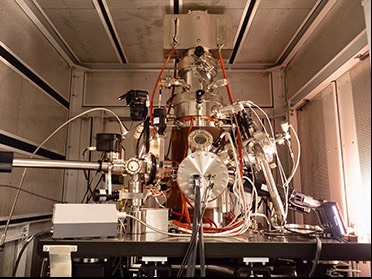Scanning Auger Electron Nanoprobe
ICAL has recently acquired this Scanning Auger NanoProbe, which features EDS (energy-dispersive X-ray spectroscopy) and EBSD (electron backscattered diffraction) capabilities. In Auger spectroscopy (AES), like SEM, a highly focused and energetically well-defined electron beam is incident on the sample, whereupon electrons ejected from the sample are analyzed in terms of their kinetic energy and quantity. Some of these electrons are characteristic Auger electrons and, much like characteristic X-rays, are the fingerprint of the atoms from which they are emitted.

Because of the low kinetic energies of the ejected Auger electrons, their escape depth is limited to a few atomic layers. Thus AES allows analysis of only the top atomic layers of the sample of interest. Therefore, Auger is a surface-sensitive technique (~5 nm) that complements the bulk X-ray microanalysis (~3 μm) of EDS. To allow observation below the surface of the sample, the system is equipped with in situ Ar-ion etching capability for depth profiling of the sample as well as charge compensation for insulating samples. The system operates under ultrahigh vacuum conditions with rapid sample introduction facilities. A secondary electron detector on this system allows high-resolution imaging, as previously described. Excepting hydrogen and helium, all elements can be detected.
In summary, the advantages of AES are:
- Low-Z elemental detection
- Quantitative analysis, mapping, linescan for AES and EDS
- Surface sensitivity of 1–5 nm
- Enhanced lateral spatial resolution for elemental analysis (<8 nm using 20 kV, 1 nA electron beam)
- Limited chemical information
- Sputter depth profiling (three-dimensional analysis)
- High-resolution secondary electron imaging of analysis area
